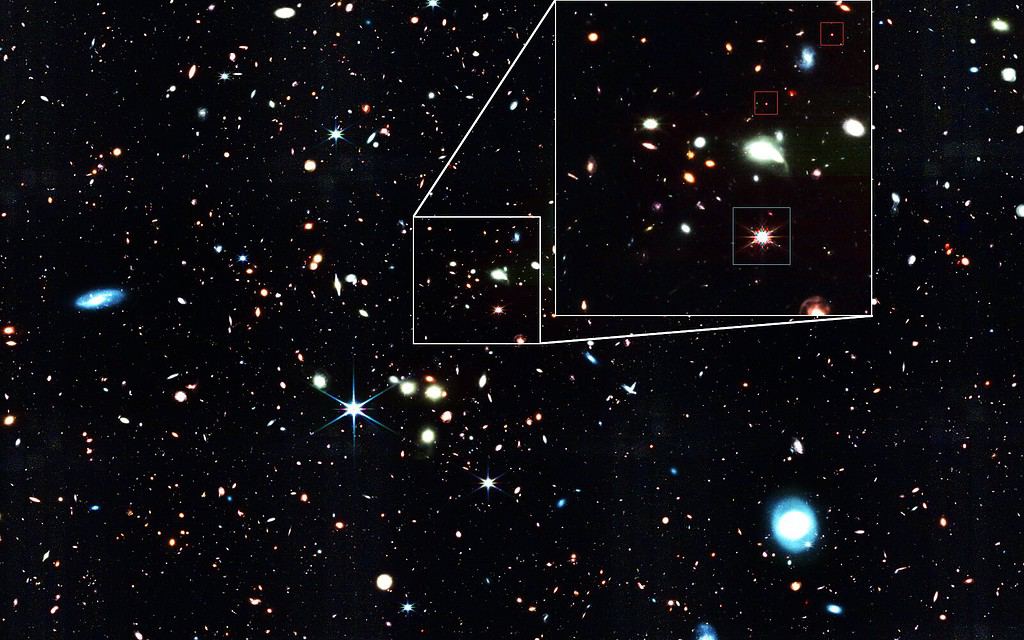
Some things are hidden in plain sight. A new discovery by the James Webb Space Telescope (JWST) published in The Astrophysical Journal has brought to light one such mystery: a significant number of faint little red dots, observed in a distant part of the universe. Although seemingly unsuspecting, this discovery could change our understanding of the origin of supermassive black holes.
Within its first year of operation, the JWST has identified these faint red dots in the universe’s distant past, at a redshift of approximately z ∼ 5 (The z-score tells you how many standard deviations a data point is above or below the mean). Light for a redshift of z ∼ 5 comes from a time roughly just one billion years after the Big Bang. As such, this observation provides a rare glimpse into the early universe, offering clues about the formation and evolution of galaxies.
Unlike anything seen by its predecessor, the Hubble Space Telescope, these objects were indistinguishable from normal galaxies until now. The JWST’s advanced infrared capabilities have allowed scientists to determine that these dots are, in fact, miniature versions of extremely massive black holes.
“Without having been developed for this specific purpose, the JWST helped us determine that faint little red dots—found very far away in the universe’s distant past—are small versions of extremely massive black holes,” said Jorryt Matthee, assistant professor in astrophysics at the Institute of Science and Technology Austria.
“These special objects could change the way we think about the genesis of black holes.”
Why It Matters
Supermassive black holes (SMBH) lie at the center of almost every large galaxy, including our own Milky Way. These cosmic phenomena have masses millions to billions of times that of our Sun and play a crucial role in shaping the galaxies they inhabit. The discovery of these little red dots suggests the existence of supermassive black holes in the early universe, challenging current models of how such massive objects could form and proliferate.
Some SMBHs snowball by engulfing astronomic amounts of matter. Thus, they become so luminous that they can be observed until the edge of the ever-expanding universe. These luminous SMBHs are called quasars and are among the brightest objects in the universe.
One of the biggest puzzles in astronomy is how some SMBH grew to such immense sizes so rapidly. The current laws of physics and our understanding of stellar explosions suggest a maximum growth rate for black holes. Yet the existence of these cosmic giants defies these constraints, raising questions about our fundamental understanding of cosmic evolution.
“One issue with quasars is that some of them seem to be overly massive, too massive given the age of the universe at which the quasars are observed. We call them the ‘problematic quasars’,” Matthee said. “If we consider that quasars originate from the explosions of massive stars and that we know their maximum growth rate from the general laws of physics, some of them look like they have grown faster than is possible. It’s like looking at a five-year-old child that is two meters tall. Something doesn’t add up.”
The little red dots identified by the JWST are essentially baby quasars. Unlike most quasars, which are overly massive and bright, these baby quasars are smaller, with masses between 10 and a hundred million solar masses and appear red due to dust obscuration. This discovery provides a new perspective on the lifecycle of quasars and supermassive black holes. It offers insights into their growth and the stages preceding their evolution into the giants we observe today.
Detection of these baby quasars was made possible by the JWST EIGER (Emission-line galaxies and Intergalactic Gas at the Epoch of Reionization) and FRESCO (First Reionization Epoch Spectroscopically Complete Observations) collaborations. These initiatives were initially designed to study the rare blue supermassive quasars and their environments.
This discovery has opened new avenues for research and raised fundamental questions about the universe’s early days.
“Black holes and SMBHs are possibly the most interesting things in the universe,” Matthee said. “It’s hard to explain why they are there, but they are there. We hope that this work will help us lift one of the biggest veils of mystery about the universe.”






